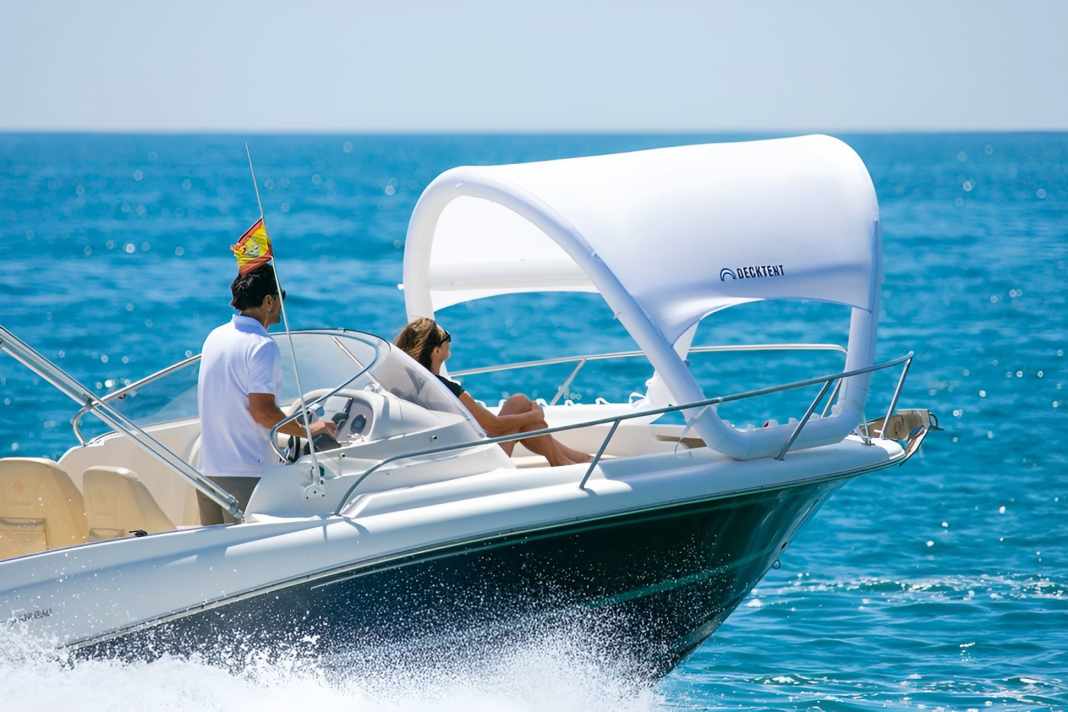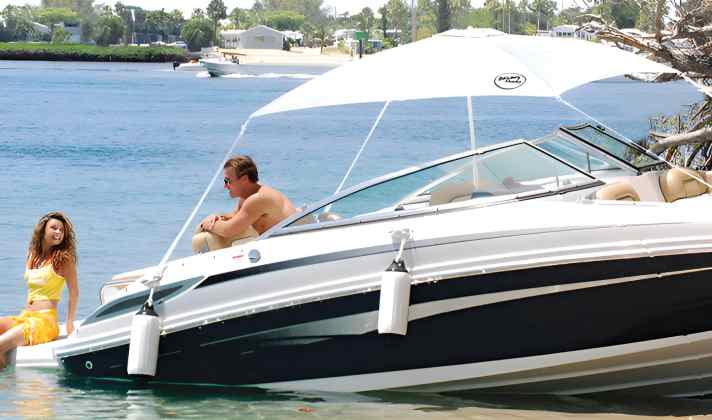





UV radiation is also getting stronger in northern latitudes. Experts estimate an annual increase of around one per cent. This may not sound like much, but it has noticeable consequences, including for motorboats and their equipment: plastics become brittle, paintwork weathers and fabrics age more quickly. This means ten per cent more radiation per decade: on sunny days in summer, the exposure in northern Europe is now comparable to what we used to be used to in the Mediterranean region.
Owners there know the consequences of UV radiation. Tarpaulins, mooring lines, wooden parts, gelcoat and even inflatable boats lose their colour, shine and strength. Accordingly, light protection is becoming increasingly important. This starts with the tarpaulin and cake stand. UV rays attack the fabric, causing it to age more quickly. The materials lose their tear resistance, softeners and coatings, they lose their shape, or the Tenax buttons tear off. At the end of the day, people's clothes have to be replaced more often.
Also interesting:
For smaller sports boats, there are usually replacements available from well-known online retailers such as svb.de, compass24.de or the yacht dealer. The question is how well this standardised product actually fits. For older boats such as an Ancora 44, built in 1973, a sailmaker is usually required. In conversation with the Kiel-based canopy specialist Segelmacherei Molkentin, we learn that the tarpaulins are precisely measured on the boat and that customer requirements such as windows, vents and ventilation bonnets can be planned in. The colour can also be chosen more or less freely. However, such a service and a custom-fit tarpaulin is only available from a professional.
People also need shade
The shipyards have come up with some ingenious designs for this purpose. Sliding mechanisms can be used to extend a sun awning out of the cockpit roof or extend the roof to the rear. But it can also be simpler. Finnish manufacturer Axopar, for example, integrates small stainless steel brackets into its coaming. Carbon fibre rods are then inserted into these. If an awning is stretched between four poles or two poles and the roof, it provides shade on the deck. It is tensioned with a pulley or simply by the bending strength of the carbon fibre tubes. The possibilities are endless.

Another simple solution is the parasol. It is attached to the railing with a special bracket. Simple parasols have clear advantages: they do not need to be guyed when it is calm, they can be orientated towards the sun and the costs are manageable. Special mounting aids are available for this purpose. They are attached with a clamping mechanism and have an opening for the sunshade pole. To set up the sunshade, the tip of the lower telescopic pole, which otherwise makes it easier to drill into the sand, must be removed. The umbrella is then ready for use on the beach. Simply put the tip back on and off you go.
Products such as the Anchorshade awning are available online and can also be set up in slightly windier conditions as the sail is tensioned sideways. But more versatile products such as the Decktent are also on the market and have various advantages such as no poles and good stowability on board.
Protection of treated wooden surfaces
Full tarpaulins are particularly popular for smaller wooden boats. They cover the entire boat and protect it completely from rain, sunlight, dust or sand in the air. Here too, the possibilities are virtually limitless. Window segments that can be rolled up or completely removable with zips - the alternatives are many and varied. In any case, the deck also benefits from this, regardless of whether it is made of teak or plastic. Wooden decks have their own rules anyway. An unpainted, dry and dirt-free wooden deck will turn grey, but cannot be destroyed by sunlight. However, it can discolour.
It becomes more complicated if the wood is treated with varnishes, oils or resins. In this case, the sun can have a destructive effect, causing paintwork to peel off and epoxies to yellow. Therefore, if you have large wooden areas on board, you can save yourself a lot of maintenance work by covering these areas with a tarpaulin. Nils Molkentin advises using light-coloured fabrics for a full tarpaulin. According to the cover expert, the heat build-up is many times higher with dark-coloured fabrics. Of course, nobody wants to cover a 50-footer after every boat visit. However, it is worth considering for small pleasure craft or if the boat is used as a holiday home, for example in the Mediterranean. Covering small pleasure craft is quick and easy, and if you are not on board your "holiday home" every weekend, it is worth the effort.
UV light leads to replacement purchases
However, plastics also lose their plasticisers over time due to UV radiation and become brittle. This can cause the handles of the lever clamps to break off. Ship windows, which are usually made of acrylic glass, suffer a similar fate. This plastic also becomes brittle over time. It forms hairline cracks or becomes brittle. Covers are available to prevent this. They are attached to the outside of the window with press studs or rubber bands and thus protect against the sun. And if you want to block out the sun like at home, you can use roller blinds.

